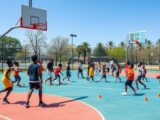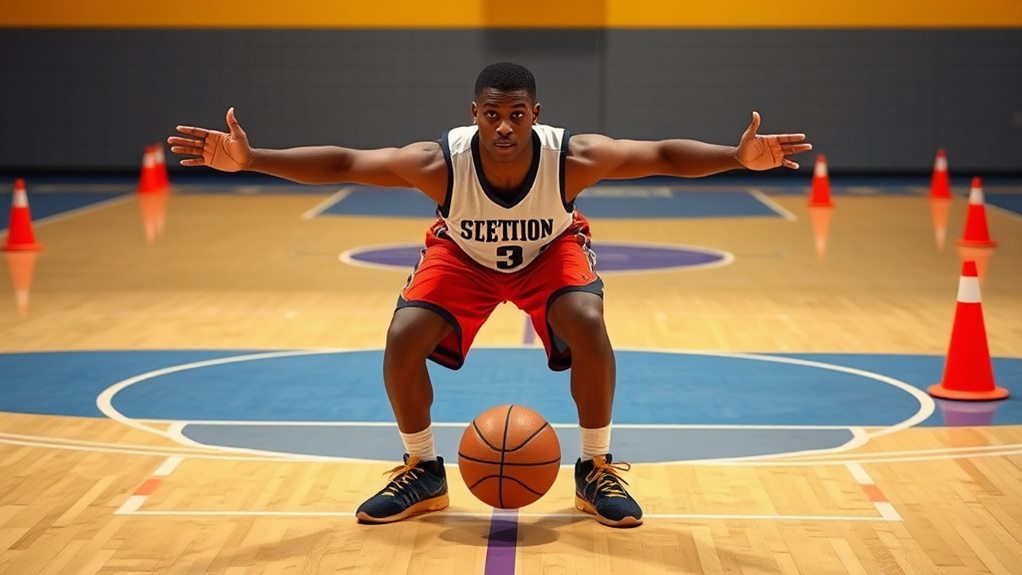
Defensive Stance in Basketball: Techniques and Drills
November 27, 2024A solid defensive stance is your foundation in basketball, essential for stopping opponents. Start by positioning your feet slightly wider than shoulder-width apart for balance. Keep your weight on the balls of your feet, and drop your hips while bending your knees for an athletic posture. Focus on the opponent's waist to anticipate their moves. To improve your skills, practice drills like the Defensive Stance Drill and One-on-One Defense Drill. These exercises enhance your agility, stability, and overall defensive effectiveness. With consistent effort, you'll master your stance and elevate your game even further.
Importance of Defensive Stance
A strong defensive stance is like the foundation of a sturdy building—it's essential for effective defense in basketball. Your defensive stance greatly influences your ability to guard opponents and disrupt offensive plays. When you maintain a good defensive stance, you enhance your lateral movement and quick reaction times, which are critical for stopping the ball and denying penetration.
Additionally, practicing defensive stance drills for beginners can help players master body positioning, contributing to better overall defensive skills. A proper stance allows you to anticipate offensive movements, increasing your chances of creating turnovers and seizing scoring opportunities.
Think of it this way: the better your stance, the more control you have over the game. Emphasizing your defensive stance during practices can lead to improved overall team performance and intensity, which ultimately contributes to winning games.
Moreover, a well-executed defensive stance is essential for maintaining balance and stability. This prevents any breakdowns that could lead to easy scores for the offense. By focusing on your defensive stance, you not only elevate your individual game but also strengthen your team's defense, making it more challenging for opponents to execute their plays.
Tips for Perfect Stance
To achieve the perfect defensive stance, start by positioning your feet slightly more than shoulder-width apart, which creates a stable base for effective lateral movement. This good stance helps you stay balanced and ready to react. Focus your weight on the balls of your feet while keeping your heels grounded. This balance aids in explosive movements when you need to shift quickly.
As defensive strategies evolve, particularly with the increased focus on perimeter defense, mastering your stance becomes even more vital to counter high-efficiency shooters.
Next, drop your hips and bend your knees to establish an athletic posture. Confirm your hips are lower than your knees for ideal positioning. This will enhance your movement efficiency during the game.
Additionally, keep your hands actively positioned at shoulder height; this not only creates a physical presence but also disrupts the offensive player's vision and passing lanes.
Lastly, concentrate on the opponent's waist. By doing this, you'll better anticipate their movements, as their waist indicates true direction. This focus is essential for quick defensive reactions.
Incorporating these tips will guarantee you maintain a good stance, giving you the advantage you need on the court. Remember, a strong defensive stance is the foundation of effective defensive play.
Feet Positioning Techniques
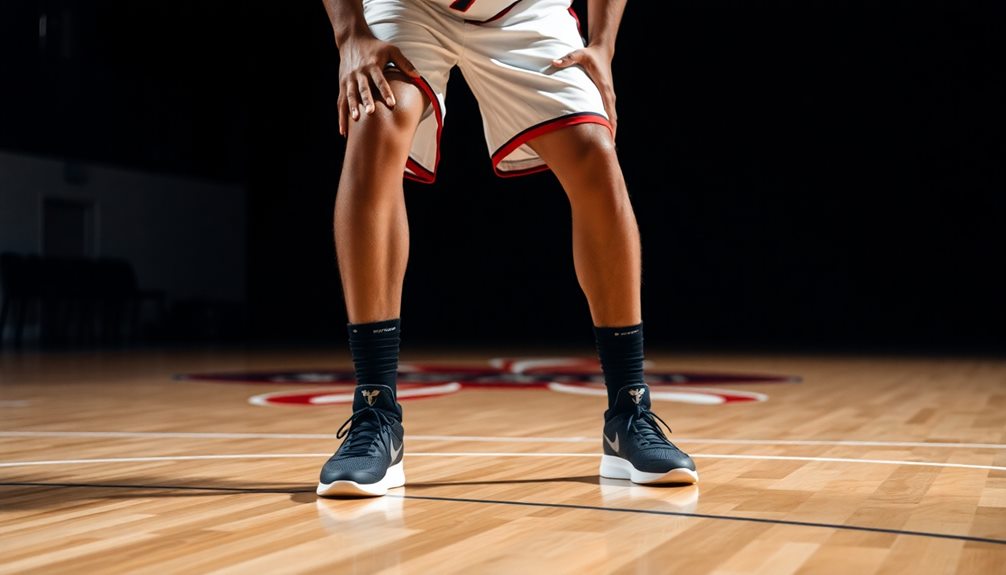
When you're on defense, proper foot positioning is essential for staying balanced and quick.
Keeping your feet slightly more than shoulder-width apart and angled outward enhances your lateral movement, allowing you to effectively respond to offensive plays.
This stance not only helps you respond explosively but also makes it tougher for opponents to drive past you.
Mastering strategic advantage gained by mastering event rules can also play a significant role in how you position yourself defensively.
Proper Foot Spacing
Maintaining proper foot spacing is essential for solid defensive positioning in basketball. Position your feet slightly more than shoulder-width apart to create a stable base, enhancing both balance and mobility. This stance allows you to effectively react to an opponent's movements, helping you adjust quickly and cut off driving lanes.
Avoid standing too upright; instead, keep a low center of gravity with your feet in that shoulder-width stance. This approach not only enhances your explosiveness but also your agility on defense. Remember, if your feet are too close together, you'll limit your lateral movement, making it harder to stay with your opponent. Conversely, if they're too far apart, you'll struggle to change direction quickly.
Adjust your foot positioning based on the offensive player's actions. This adaptability optimizes your defensive effectiveness, enabling you to anticipate and respond to their next move.
Lateral Movement Techniques
Effective lateral movement is essential for any defender looking to stay in front of their opponent. To achieve this, position your feet slightly more than shoulder-width apart. This solid base allows for effective lateral movement without losing balance. When you slide, avoid crossing your feet; instead, push off with the foot opposite the direction you're moving. This technique keeps you stable and agile.
Maintaining a low center of gravity is vital, so bend your knees and drop your hips. This posture enhances your agility and responsiveness during lateral movement, making it easier to react to your opponent's actions. Additionally, angle your feet outward slightly while in a defensive stance. This positioning maximizes force and stability, especially during quick directional changes.
To reinforce these techniques, practice lateral movement drills like cone drills. These drills help improve your footwork and agility, which are essential components of effective basketball defense.
Weight Distribution Strategies
To effectively defend, you need to place more than half your weight on the balls of your feet, which boosts your agility.
This technique is essential for mastering technical skills and consistent practice, as it allows you to respond quickly to your opponent's movements.
Keeping your heels grounded guarantees you stay stable, making it harder for opponents to knock you off balance.
Optimal Weight Placement
Achieving ideal weight placement in your defensive stance is vital for maximizing your performance on the court. To establish ideal weight placement, you should position more than half of your weight on the balls of your feet while keeping your heels grounded. This balance not only provides stability but also guarantees you're ready for explosive movements when facing offensive players.
Shifting your weight slightly forward enhances your reaction time, allowing you to respond quickly to any offensive maneuvers. Maintaining a low center of gravity is important; push your hips back behind your heels and keep your knees pointing forward. This positioning aids in balance and facilitates effective directional changes.
Proper weight distribution helps prevent defensive breakdowns, keeping you stable and prepared for whatever comes your way. Practicing weight distribution drills will improve your balance during lateral movements, making your defensive plays more effective.
Stability and Agility Balance
Mastering your weight distribution lays the groundwork for enhancing stability and agility on the court. To achieve this, focus on keeping more than half of your weight on the balls of your feet while your heels remain grounded. This positioning provides the stability you need while allowing for quick, agile movements.
Bend your knees and drop your hips to lower your center of gravity, which will help you move laterally faster and change directions with ease when defending against opponents.
Ensure your hips sit behind your heels with your knees pointed forward. This alignment supports explosive movements, essential for reacting to offensive plays. By shifting your weight forward while maintaining a balanced stance, you'll be ready to react explosively, closing gaps and contesting shots more effectively.
Regularly practicing drills that emphasize weight distribution and balance will enhance your muscle memory, leading to improved stability and agility during game situations.
Incorporate these strategies into your training, and watch your defensive game elevate as you become more responsive and effective on the court.
Athletic Posture Essentials
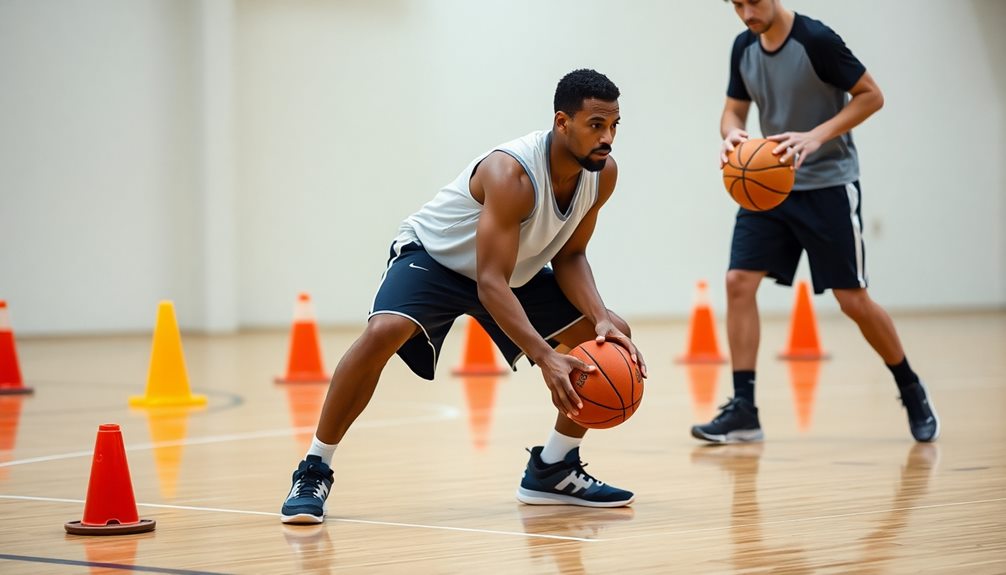
Your athletic posture is the foundation of effective defense in basketball. To establish a solid stance, focus on these athletic posture essentials:
- Hips and Knees: Drop your hips and bend your knees, ensuring your hips are lower than your knees. This positioning enhances stability and allows for quick movements, similar to the way players enhance their passing efficiency through proper technique and positioning.
- Back Alignment: Maintain a straight back and puff out your chest. Proper alignment promotes balance and visual awareness, vital for anticipating your opponent's moves.
- Weight Distribution: Keep your weight balanced on the balls of your feet while grounding your heels. This technique supports agility without compromising stability, enabling you to shift directions swiftly.
Consistent practice of these essentials will reinforce your muscle memory, helping you return to an ideal stance during game situations.
By mastering your athletic posture, you'll be better equipped to react quickly and efficiently, facilitating lateral movement and explosive sprints when necessary.
Defensive Awareness Practices
After establishing a solid athletic posture, the next step is to develop defensive awareness. Focus on your opponent's waist or chest during play; this gives you better insight into their movements and allows for quicker reactions. By maintaining a high level of visual awareness, you can anticipate offensive strategies and adjust your positioning effectively.
Racial integration in sports hasn't only enriched the competition but also fostered an environment where diverse playing styles contribute to defense strategies, promoting a culture of inclusivity and teamwork inclusivity and equality.
Keeping your hands up is essential for creating a physical presence. This not only disrupts passing lanes but also impedes the offensive player's line of sight. Regularly analyzing and recognizing your opponent's tendencies will enhance your ability to predict and counter their movements, greatly improving your defensive effectiveness.
Don't underestimate the power of communication with your teammates. It's vital for maintaining defensive awareness and allows for coordinated efforts in help defense and covering offensive players. When you talk to each other on the court, you create a more cohesive defensive unit.
Incorporating these practices into your game will elevate your defensive skills. By honing your defensive awareness, you'll become a more effective defender, making it tougher for opponents to execute their plays and score.
Effective Drills for Improvement
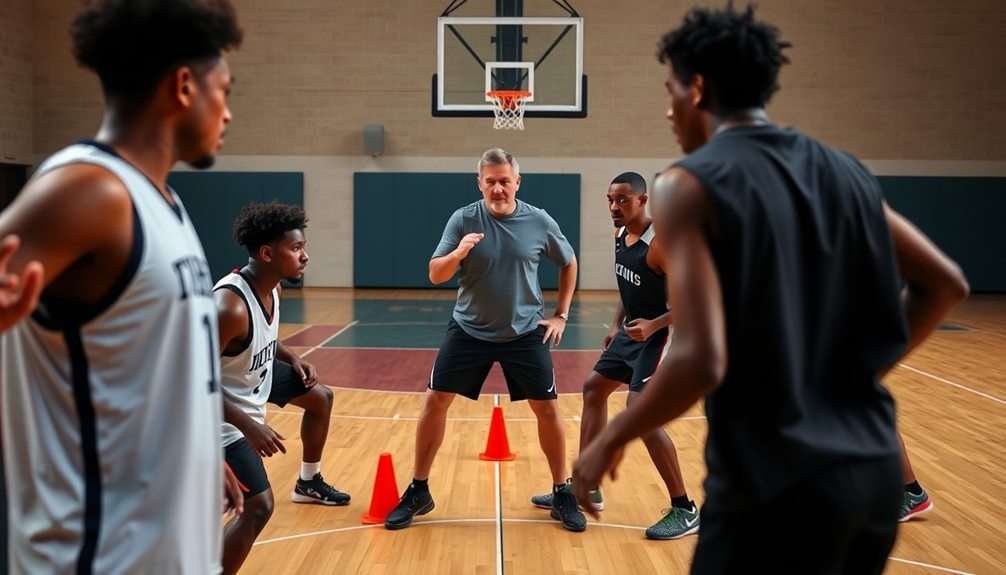
Effective drills are essential for honing your defensive skills in basketball. Incorporating drills that focus on teamwork and individual technique can greatly enhance your overall performance.
These drills not only improve your individual abilities but also enhance team dynamics, making your defense more effective overall. Here are three good drills you should incorporate into your practice routine:
1. Defensive Stance Drill: Focus on maintaining a low center of gravity while practicing quick lateral movements. This drill enhances your overall defensive effectiveness and helps you stay agile during games.
Additionally, you can benefit from cardio workouts that complement your training by improving your speed and endurance.
2. Closeout Drill: Work on contesting shots without fouling. This drill emphasizes balance and control as you approach the shooter, ensuring you can challenge shots effectively while minimizing the risk of fouls.
3. One-on-One Defense Drill: This drill allows you to practice individual defensive skills against various offensive styles. It's a good way to develop your positioning and angles while sharpening your defensive strategies.
Incorporating these drills into your training will considerably improve your defensive skills.
Long-term Development Strategies
To build a strong defensive foundation in basketball, it's important to focus on long-term development strategies that stick. Start by implementing regular defensive drills that simulate game situations. This reinforces skills and promotes muscle memory, so you're prepared for the defensive end in real games.
Incorporating techniques like effective marking and pressing can enhance your defensive capabilities during practice.
Utilize video analysis to give personalized feedback on your defensive techniques. This will help you identify areas for improvement based on your strengths and weaknesses.
Don't forget to encourage ongoing education on advanced defensive concepts and techniques. This creates a culture of continuous learning, enhancing your understanding and execution of defense.
Tracking individual and team defensive metrics is significant. Keep an eye on stats like steals, blocks, and points allowed to assess progress and guide your training focus. This not only promotes accountability among players but also motivates you to improve.
Lastly, incorporate conditioning drills that emphasize agility and lateral movement. Building stamina and quickness is critical for effective long-term defensive play.
Conclusion
To sum it up, mastering your defensive stance isn't just important; it's the secret sauce that'll turn you into a basketball defensive beast! Imagine being so quick and agile that opponents won't even dare to look your way. With the right techniques and drills, you won't just improve—you'll dominate on the court! So, lace up those shoes, get ready to hustle, and watch as your defensive prowess transforms you into the ultimate game-changer every time you step onto that hardwood!

